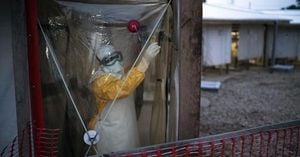Rising concerns about the H5N1 avian influenza, commonly referred to as bird flu, have become more pronounced following alarming reports from both Canada and the United States. Just recently, health officials confirmed one confirmed case of H5N1 infection among wild birds in the Northwest Territories, alongside the first human case reported in British Columbia, raising serious alarms about the virus’s potential spread and the effectiveness of existing surveillance measures.
Collision of wild bird populations with domestic fowl has long been recognized as the root of such outbreaks, prompting public health officials to keep a close watch on both wildlife and commercial poultry populations. The BBC reports one H5N1 strain has now been confirmed to have caused the infection of a teenager, whose case is often characterized as the first human infection from this virus strain detected on Canadian soil.
Chief Public Health Officer of the Northwest Territories, Dr. Kami Kandola, confirmed the detection of the H5N1 strain after tests were performed on wild ravens. The report indicated no immediate outbreak, and experts believe the risk to other avian species remains low by current standards. Nonetheless, strict guidelines were set up to maintain public safety, including avoiding contact with wild birds and reporting any unusual sightings of sickened wildlife.
The British Columbia incident describes the condition of the affected teenager as stable yet serious, reflecting the unpredictable nature of H5N1 infections. This unique strain has been previously seen affecting birds predominantly, with very few documented cases found among mammals and people. It remains unclear how this teenager contracted the virus, as investigations have revealed no definitive link to poultry or other domestic birds, creating fears about potential unknown vectors.
Total counts of human infections from H5N1 remain sparse worldwide, with numbers hovering around 900 confirmed cases since the first identification of the strain back in 1996. Most human cases typically derive from direct contact with infected birds. Still, concerning trends have emerged, as the virus has shown capacity to cross species barriers — highlighting the necessity for improved monitoring.
Maria Van Kerkhove from the World Health Organization has publicly underscored the need for stronger surveillance systems for detecting H5N1’s presence among wild and domestic avian populations worldwide. “What we really need is much stronger surveillance — not just for birds, but across mammals too, from wild species to commercial livestock,” she remarked, detailing the interconnected nature of outbreaks worldwide and the broad impact of avian flu.
To this end, the WHO has emphasized the relevance of constant monitoring — including environmental samples such as wastewater and sediments within habitats where wild birds frequent — to preemptively identify any changes within viral behavior posing threats to public health.
Interestingly, genomic investigations medical teams have performed on the viral samples from the Canadian teen revealed the virus was not linked to the strains responsible for multiple outbreaks recently affecting poultry farms across the province. This disconnect offers some relief, but the complete lack of known human infection cases to the spread of the virus from birds or domestic animals intensifies the urgency for greater scrutiny.
Despite steps taken by officials to heighten awareness through advisories and public health guidelines, it remains true the risk of human infections could potentially increase should the virus adapt to facilitate efficient human transmission. Depressing data from laboratory confirmations globally evidenced similar mutations leading to heightened transmissibility, causing practitioners to advocate for preventative measures not only for farm animals but for general public health practices aimed at curbing cross-species viral exchanges.
Health officials have warned against complacency, as evidenced by the growing infections reported sporadically throughout both U.S. and Canadian populations, urging those who have come to close quarters with bird populations to take heightened precautions. Recommendations include limiting direct contact with sick or dead wild birds, regular hand washing after handling domestic pets who may roam freely outdoors, and seeking immediate medical assistance if respiratory symptoms appear following such exposure.
The prevailing circumstances ripple outward, prompting echoings of pandemic preparedness as global attention returns to the H5N1 strain. Surveillance across nations should intensify if incidents of infection among wild, migratory birds continue to rise; more frequently than not, entry points for novel pathogens originate from engagements with nature, underlining the necessity of biosurveillance.
Educational efforts must also accompany the increasingly dire calls for awareness, ensuring individuals retain adequate knowledge concerning these zoonotic risks, translated succinctly through public health messaging. Restrictions against handling of wildlife, usage of personal protective equipment, alongside behavioral adjustments can empower populations to mitigate potential exposures effectively.
Canadian health departments have urged continual vigilance and assessments targeted toward regions at risk, chiefly regions with established poultry farming; interactions with migratory birds pose significant risks of inadvertent infection, as evidenced by the virus’s lineage entering northward populations. Maintaining public engagement concerning changes or advisories follows suit, seeking to shield communities from the adversaries of yet another public health threat.
Public health officials are not only faced with the immediate crises dwell among current cases but also preparing for the challenges likely to accompany the evolution of the H5N1 strain. Ensuring systems capable of identifying risks quickly will shape future responses accordingly — paving new paths toward harmonization of inter-agency efforts across the public health spectrum.
The H5N1 situation serves as a solemn reminder of the perpetual threat of zoonotic diseases bridging from animals to humans, requiring strong vigilance and community action amid the onset of disease surveillance and data collection efforts. Obvious signs of higher virulence and adaptability often present motivation enough to address preventive solutions head-on — leading dedicated groups of scientists, doctors, and public health professionals committed to mapping the attributes of change and daily risks imposed by wildlife interactions.
With winter approaching — the season thought to encourage close interactions between humans and wildlife — the chance of increased transmission must amplify due diligence. Exposure to migratory birds could prove potentially precarious as the human vector becomes intentionally closer to nature with seasonal festivities on the horizon. Daily vigilance accompanied by preventive practices should remain top-of-mind as individuals engage outdoors.
Public inquiries for new solutions rewiring animal management policies to include heightened biosecurity standards among domestic flocks closely mirror calls for attention at the disposal of agricultural transparency and worker safety. Only with these systemic enhancements can public confidence burgeon, ensuring collective thought aimed toward erasing risks and restoring harmony between natural ecosystems.
Only through proactive dialogues between environmental health and wildlife conservation efforts can societies adapt seamlessly. Swirling conversations woven through collaboration must clearly define the relationship between public policy and biological consequences posed by domesticated animal behaviors within environmental contexts, creating awareness equally shared between human and animal populations.
The lessons learned must inform collective, actionable responses as communities build up resilient frameworks focused on environmental health outcomes. Rounding corners moved beyond single-case inquiries will necessitate public discourse bridging awareness conversations about the increasing rates of H5N1 interceptions across populations, turning elucidation of animal host relationships inward toward improving standards and protecting every vulnerable community resident.



